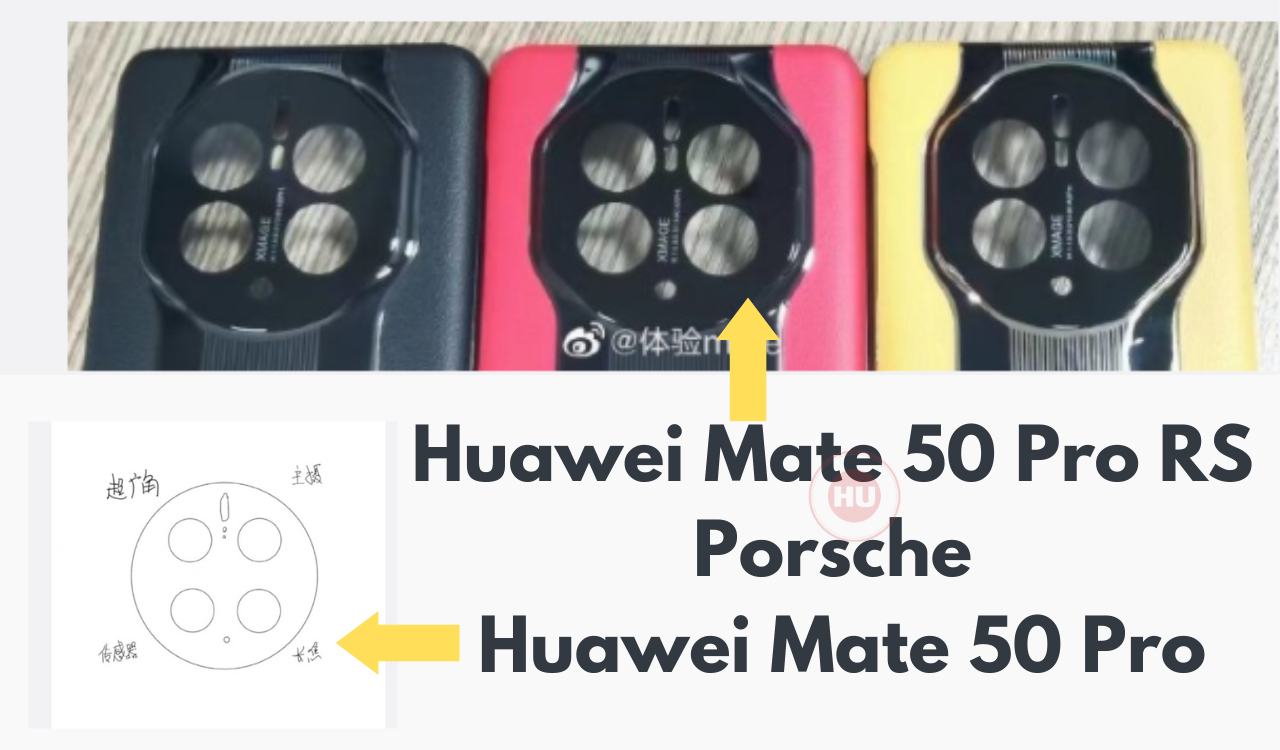Huawei News
Huawei Mate 50 Pro and RS Porsche rear leaked: XMAGE, Octagonal Lens

Huawei HarmonyOS 3 version for smartphones has recently launched and now the next topic is circulating over the internet is the Huawei Mate 50 series flagship devices. The whole series is said to be announced in the next month.
Like the past series, the new Mate 50 series leak is around the corner. A Weibo tipster has shared a fresh leak, the post consist, of the back panel/rear camera design of the Mate 50 RS Porsche design as well as the other leak including the Mate 50 Pro back design.
Huawei Mate 50 series – Mate 50e, Mate 50, Mate 50 Pro, and Mate 50 RS may debut on September 07, 2022. As per the image below, the Mate 50 RS variant has a black, red, and yellow cover, and the camera layout adopts an octagonal design. The display rear camera is equipped with Huawei Imaging XMAGE. In early July this year, the new brand Huawei Imaging XMAGE was officially released.
What about Mate 50 Series Processor?
Huawei Mate 50e is expected to arrive with Snapdragon 778G, all other Huawei Mate 50 series are equipped with SM8425 (Snapdragon 8 Gen 1 4G chip). It is reported that the Huawei Mate 50 series, the standard version uses a centered punched straight screen, and the Mate 50 Pro uses a notch curved screen but cancels the large curvature design of the waterfall screen.
Furthermore, the Huawei Mate 50 Standard variant may launch with a 90Hz screen, and the Mate 50 Pro and Mate 50 RS are equipped with a 120Hz screen.
Meanwhile, the three Huawei models BNE-AL00, DCO-AL00, and CET-AL00 have been spotted on the TENAA listing, all the devices will run the HarmonyOS system, but none of them support 5G.

Huawei News
Huawei Smart Screen S5 Pro sale details

Huawei officially started the sale of its new Smart Screen S5 Pro. The latest smart screen comes with three sizes of 65/75/85 inches and supports Huawei Lingxi pointing remote control, 4K super projection and other functions.
Huawei Smart Screen S5 Pro sale price
- 65 inches 6499 yuan
- 75 inches 8499 yuan
- 86 inches 11999 yuan
The entire Huawei Smart Screen S5 Pro series supports Lingxi pointing remote control , which can realize operations such as sliding, tapping, dragging, circling and jumping; the smart screen supports the super desktop function, which can realize large-screen operation of mobile phone apps.
Huawei Smart Screen S5 Pro is equipped with a 4K flagship main core + AI vision chip, which can realize functions such as smooth portrait tracking, AI fitness, children’s sitting posture and distance reminders, AI somatosensory games, ambient light perception, etc.; it has 3 pre-installed HDMI2.1 interfaces, standard 4GB+128GB storage combination, and supports dual-band Wi-Fi 6.
The Huawei Smart Screen S5 Pro series is equipped with a four-unit audio system as standard, which supports surround stereo effects. Users can cast 4K video content from apps such as Huawei Video, Bilibili, Mango TV, Tencent Video, Youku Video, and iQiyi to the smart screen , with a frame rate of 60FPS and a delay of about 80 milliseconds.

Huawei News
Huawei MateBook GT laptop arriving soon

Huawei is expected to release a new MateBook GT 14 laptop. The device appeared on the Huawei Smart Life App in May this year. The 3C certification information shows that the computer model is ENZH, produced by Wuxi Dengyuan Electronic Technology Co., Ltd., and is equipped with the same 140W power adapter as the MateBook X Pro 2024.
As per the Geekbench benchmark database, the ENZH laptops have three processor versions: Intel Core Ultra 5 125H / Ultra 7 155H / Ultra 9 185H .
In addition, the launch of Hongmeng Smart S9 and Huawei’s all-scenario new products has been officially announced to be held on August 6, which will bring a variety of products such as headphones, mobile phones, smart screens, etc.

Huawei News
Huawei Smart Screen S5 Pro comes with 4 speakers

Huawei Smart Screen S5 Pro is all set to go on sale tomorrow. It has now appeared in the Huawei Smart Life App and has three size versions to choose from.
Huawei Smart Screen S5 Pro has three sizes, all equipped with 4 speakers as standard , and no ads when turned on by default. Huawei Smart Screen S5 Pro series sizes are 65 inches, 75 inches and 86 inches.
The screen material is LCD, supports 120Hz/240Hz refresh rate, and the entire series is standard with 4 speakers and 4GB+128GB memory combination, and supports dual-band WiFi 6 and HDMI 2.1.













